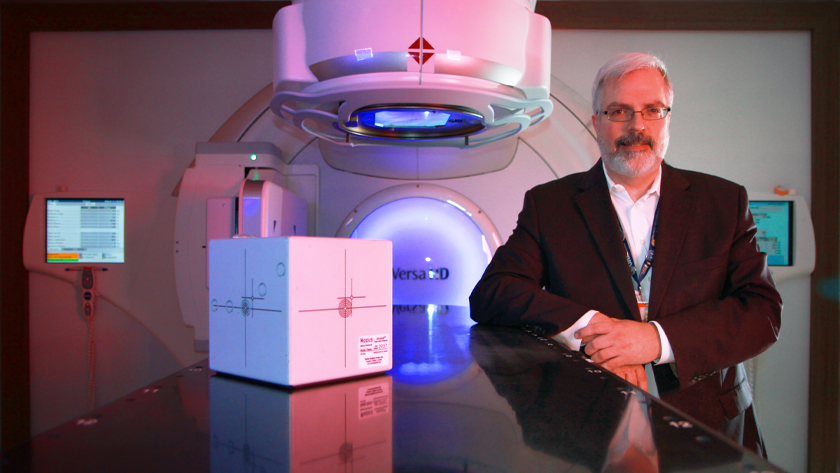
The Penta Guide—an advanced tool that looks like a simple six by six-inch cube—is now an integral part of radiation therapy departments around the world.
"We use these invisible beams to kill cancer cells in radiation therapy, but they can damage healthy tissue just as easily. It’s critical that the linear accelerators—linacs for short—deliver therapeutic radiation in a way that is precise and accurate. We invented the Penta Guide to help physicists check these linacs every day,” explains Dr. Jean-Pierre Bissonnette, who is one of the inventors now celebrating the 15-year anniversary of its invention.
The development of the technology at UHN’s Princess Margaret Cancer Centre (PM) was a team effort. “The Penta Guide would not have been possible without the help of individuals with expertise in physics, engineering as well as clinical expertise,” says Dr. Bissonnette. Other inventors are Dr. Tom Purdie, who is still at UHN, Dr. David Jaffray, who is now at MD Anderson in Texas, and the late Dr. Michael Sharpe.
Embedded within Penta Guide is a set of five precisely placed spherical air pockets. These spheres show up in imaging scans and serve to represent a simplified version of a patient’s anatomy.
Medical physicists at PM and around the world use Penta Guide to improve and speed up daily checks to ensure the accuracy of the linacs.
With support from Commercialization at UHN, the system was licensed in 2006 to Modus Medical Devices, now part of IBA Dosimetry. Since then it has been updated with further innovations from the UHN team.

Photo showing Dr. Bissonnette positioning the Penta Guide on a linac machine. Target marks on the surface of the Penta Guide are used, in combination with special software, to position it and to calibrate the imaging and radiotherapy beams.
“Penta Guide is an excellent example of the success that follows when researchers and commercialization partners work together to solve a common problem. We have delivered over 5,000 Penta Guides to customers in over 90 countries. This technology is helping to ensure high-quality radiotherapy for cancer patients around the world,” says John Miller, Founder of Modus Medical Devices.
“After 15 years, even in an area as fast-paced as cancer therapy, the Penta Guide is still in use and still making a difference in the lives of patients. Its simple, effective design means that since 2009 it has been included with the sale of every new linac from one of the two leading manufacturers,” says Dr. Bissonnette, who is the Associate Head of Medical Physics at PM and an Associate Professor in the Departments of Radiation Oncology and Medical Biophysics at the University of Toronto.
It is one of many innovations at UHN that have been successfully commercialized to improve care worldwide while supporting Ontario’s biotechnology economy.
“As more imaging is being integrated into cancer therapies, the demand for tools such as the Penta Guide is growing, so our work is not done,” concludes Dr. Bissonnette.

